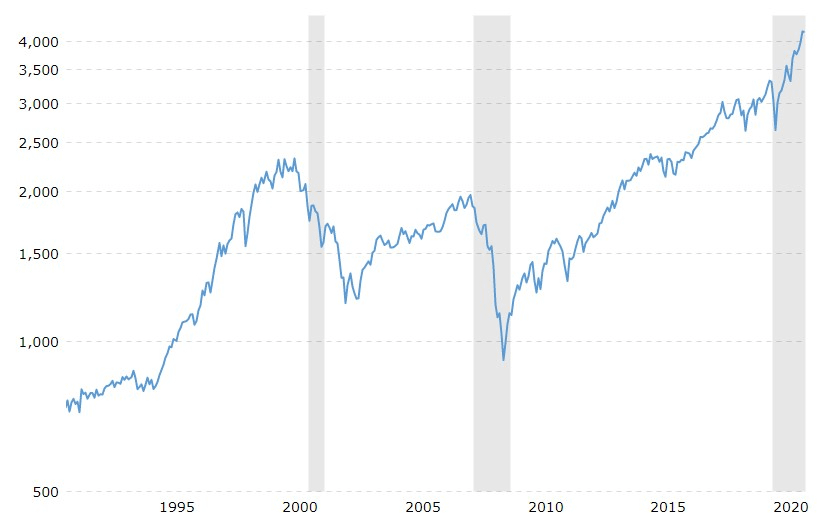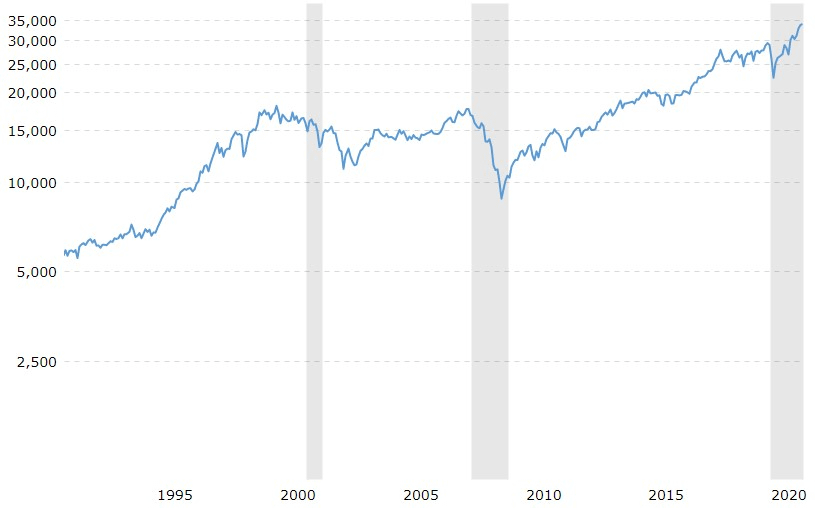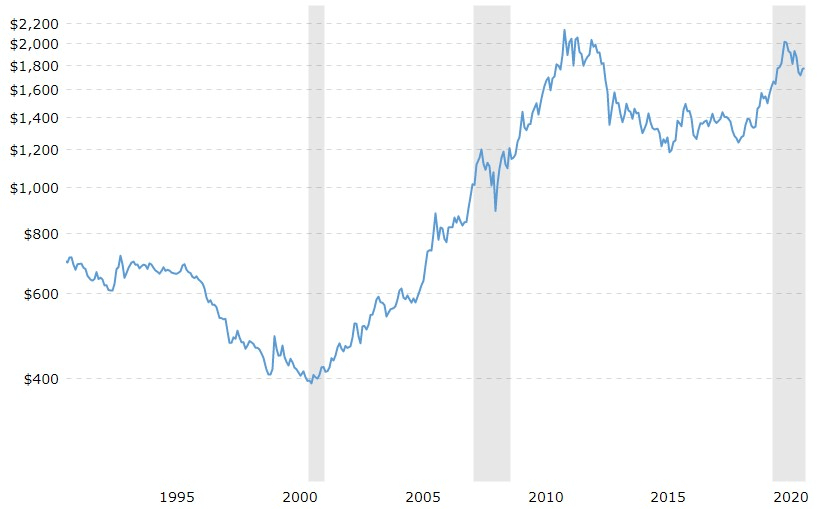Defensive investment strategies are designed to protect your portfolio from losses rather than to increase its value. There are two primary reasons for considering a defensive strategy.
- You’re approaching retirement. If you’re nearing retirement or facing other life circumstances that make preserving your capital more important than growing it, defensive investment strategies are a logical course.
- You expect a market downturn. If you believe that a bull market has run its course and the bear is lurking on the horizon, you may elect to take profit on volatile investments and move all or part of your portfolio into a defensive position.
Personal concerns like impending retirement or plans to buy a home or pay tuition are relatively predictable. Market conditions are much less predictable, but some signs can indicate that a downturn is approaching.
Are Markets at a Turning Point?
US stocks have been in a bull market since March 2009, a relentless 12-year surge of nearly continuous gains, punctuated by brief drops followed by immediate surges. That’s been a profitable period for US stock investors. It also raises concerns about “recency bias”: the assumption that things will keep going as they have been recently.
We’ve seen periods with dramatic stock gains before. The bull markets of the late 90s and the mid-00s were followed by steep market crashes, recessions, and crushing losses for investors who had settled into an aggressive investment pattern.

Markets bounced back, but investors who adopted defensive investment positions before the crashes suffered less damage. Compare the chart above to this chart of the more defensive blue-chip Dow Jones industrial index.

The Dow suffered much less severe losses than the S&P 500 in both the 2001 and 2008 recessions.
⚠️ Warning signs
Several indicators suggest that markets are moving into risky territory.
- Stock valuations are high relative to earnings.
- Corporate debt levels are at levels similar to those seen before the 2008 and 2001 market crashes.
- Margin debt – money investors borrow from brokers to make stock purchases – is at historic highs.
- Banks and hedge funds are using creative financing methods like “equity total return swaps” to disguise speculation using borrowed money.
These indicators raise suspicions that the current bull market may be peaking, but that’s not a consensus view. Many analysts also believe that the end of the COVID-19 pandemic could propel an economic recovery and push markets even higher.
Rule No.1: Never lose money. Rule No.2: Never forget rule No.1.
Warren Buffet
Markets rise and fall. Recessions and bear markets happen. Nobody can time exactly when they will happen, but when investors face concerns about overstretched markets, many of them begin considering defensive strategies. Understanding those strategies can help you preserve your capital when a bear market arrives.
8 Simple Defensive Investment Strategies
These are some of the most common defensive investment strategies. Most defensive investors will combine several of these methods.
1. Use Stop Loss Orders
A stop-loss order is a standing instruction to your broker to sell a stock if the price falls to a certain point. A stop-loss order can protect you from a sudden steep decline in a stock’s value. You won’t want the order to be triggered by normal fluctuations in value, so you’ll need to study a stock’s trading patterns and set your stop-loss order below the current support level.
⚠️ The Risk: Stop loss orders may take some time to execute, so if the stock’s value is in a steep fall, your selling price could be well below the point at which you set your order.
2. Rebalance Your Portfolio
Many investors choose a specific asset allocation designed to fit their risk profile. This allocation defines what percentage of the portfolio is invested in each asset class. Over time some assets perform better than others, which moves the portfolio away from the original allocation. Rebalancing typically involves selling part of the high-performing section of the portfolio and adding to the low-performing classes. It sounds strange to discard productive assets in favor of less productive ones, but the high fliers have farther to fall when things turn down, and history shows that over time the performance of different asset classes tends to equalize.
⚠️ The risk: rebalancing will maintain your chosen asset allocation, but if your situation or the market environment is changing fast, you may need to go farther and revise your allocation to take a defensive position, especially if you’re currently maintaining a relatively aggressive allocation.
3. Drop Hot Stocks
Heavily hyped meme stocks are drawing a great deal of attention in today’s market. Investors drawn by the publicity and the recent gains get caught up in “FOMO,” or Fear of Missing Out, and pile into these stocks even at extraordinarily high valuations.
If you’re taking a defensive position, you’ll want to avoid these popular stocks. When markets turn down, stocks with very high valuations tend to fall fastest and hardest. If you’re moving toward a defensive position, you’ll want to move away from stocks with high visibility and overstretched valuations.
⚠️ The risk: dropping your fastest-growing assets while markets are still on the upswing can cut your gains.
4. Stock Up on Boring Stocks
Many of the stocks that perform best in a downturn are the ones that rarely get attention. Consumer staples hold up during recessions: people don’t stop using soap, toothpaste, or toilet paper. Auto parts and repair companies thrive as consumers fix old cars instead of buying new ones. Utilities and other providers of vital goods and services tend to hold their value. These companies are less likely to be hyped up and overvalued and have less downside in a bear market. Look for stocks that meet the criteria for value investing.
⚠️ The Risk: in a serious market crash, even resilient stocks can lose value, though they aren’t likely to lose as much as the high flyers.
5. Dial In the Dividends
Dividend-bearing stocks are a staple of the defensive portfolio. Dividends are typically paid as a flat amount per share, so the dividend yield rises as the stock price falls. If a stock selling at $50/share pays a dividend yield of $2/share, the yield is 4%. A price drop to $30/share with the same dividend puts the yield at 6.67%. If you buy in at that price, your yield remains the same even if the stock price rises, an opportunity for both income and capital gain.
When the price of a dividend-paying stock falls abruptly, investors seeking yields tend to buy in and stabilize the price. This makes stocks with a strong history of dividend payment and dividend growth a core part of most defensive portfolios.
⚠️ The risk: if a company is short of cash, it may have to reduce or eliminate its dividend. Watch out for companies with high debt loads, falling sales, or a weak cash position. An exceptionally high dividend may indicate a distressed company trying to shore up its stock price.
6. Focus on Fixed-Income Investments
Fixed-income investments are another natural defensive move. You gain an income stream, and as long as the issuer doesn’t default, your capital is safe. US government or municipal bonds are safest, but a well-diversified selection of highly rated corporate bonds will have higher yields with a very low risk of default.
⚠️ The Risk: If interest rates are low, your gains from fixed-income investments may not be high enough to keep up with inflation.
7. Go for Gold
Investors have traditionally viewed gold as a “safe haven” investment during times of economic turbulence. As we see in the chart below, gold has often – but not always – gained in value during recessions, including the last two US recessions.

Buying and holding physical gold can be complicated, but investors can gain gold exposure by buying shares in gold mining companies or gold-based ETFs.
⚠️ The Risk: Gold prices have not always risen during recessions (though they have seldom fallen significantly), and with gold prices currently at record highs, there may be a limited upside.
8. Concentrate on Cash
When markets turn down, cash is king. That’s not just because cash holds value when stocks fall. For seasoned investors, a market crash isn’t a disaster. It’s an opportunity. A strong cash position leaves you ready to pick up shares of quality companies at bargain prices. You won’t call the bottom exactly – nobody ever does – but if you’re selling high and buying low, you’re on the road to profit.
⚠️ The Risk: If you move to cash too soon, you’re holding an asset that will not increase in value. Sitting on a hoard of cash while stocks keep rising is not good for your state of mind or your account balance.
Selecting Your Defensive Investment Strategy
Most investors who pursue a defensive strategy will use some combination of these methods. You won’t want to move your entire portfolio to bonds, dividend-bearing stocks, or cash, but you may want to adopt a new asset allocation weighted toward these defensive investments.
The defensive strategy you choose will be determined by your financial situation and by your reasons for selecting a defensive investment strategy.
- If you’re approaching retirement and you need income from your investments, you will probably want a portfolio weighted heavily toward fixed-income securities and dividend-bearing stocks.
- If you’re retiring early and you want to keep some growth opportunities, you may choose to move a portion of your portfolio into a defensive income-generating stance and retain another portion in more aggressive investments.
- If you’re concerned that markets are overstretched, but you don’t think a crash is imminent, you may want to maintain a more aggressive stance and focus on protecting your positions with stop-loss orders and rebalancing your portfolio regularly.
- If you believe that a market crash is imminent, you may wish to take up a fully defensive position with a significant cash component held ready to pick up shares in strong companies when they reach attractive valuations.
There are many possible reasons for adopting a defensive strategy. The specific defensive moves you will take will depend on those reasons. You may wish to consult a qualified financial advisor to clarify your reasons and select the methods that serve them best.
Reviewing the Risks
Every investment strategy involves risk, and defensive strategies are no exception. Consider these possibilities.
- Lost gains. A defensive strategy will protect you in downturns, but it will underperform if markets stay strong. Going defensive too early can cost you money.
- Incomplete protection. Even a defensive portfolio can take a beating in a serious downturn. It probably won’t lose as much as an aggressive portfolio would, but it can still lose.
- You could be too late. If markets are already on their way down, you may not be able to recalibrate your portfolio in time to avoid significant losses.
A defensive portfolio is not likely to deffer serious losses. The risk is more likely to come from the timing of your transition to a defensive position. The penalty is likely to be foregone gains, not large losses.
Is It Time to Play Defense?
Nobody can time the market exactly. That’s one of the basic axioms of investing. We can study indicators and trends, but nobody can predict exactly what will happen or when. That’s why investors typically hedge their bets and maintain balanced portfolios: there’s always the possibility that things will change.
Analysts have different opinions on today’s market. Some predict a market downturn, pointing to sky-high valuations and soaring debt levels, among other indicators. Others believe that as vaccination rates rise and the COVID-19 pandemic winds down, economic recovery will drive markets higher. It’s up to each investor to decide what they expect and to recognize that their expectations could be wrong.
A defensive investment strategy may not fit every investor’s needs at any given time. It’s still useful to know how to play defense and when it’s time to play defense!























